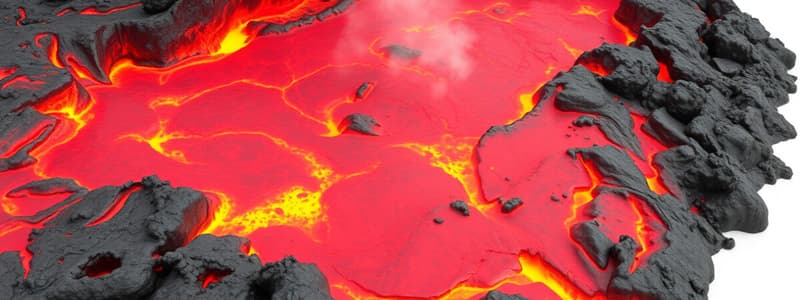Podcast
Questions and Answers
What is the difference between explosive and effusive activity?
What is the difference between explosive and effusive activity?
- Effusive eruptions have low viscosity magma. (correct)
- Explosive eruptions involve gases escaping easily.
- Explosive eruptions blast rock and lava into the air. (correct)
- Effusive eruptions occur with cooler magmas.
What is magma viscosity and how does silica affect it?
What is magma viscosity and how does silica affect it?
Viscosity is the resistance to flow; higher silica increases viscosity.
How does the composition and temperature of magma affect its viscosity?
How does the composition and temperature of magma affect its viscosity?
The amount of dissolved gases can also affect viscosity.
What happens to dissolved gases in magma as it nears the surface?
What happens to dissolved gases in magma as it nears the surface?
How do viscosity and magma gases relate to eruption types?
How do viscosity and magma gases relate to eruption types?
What is the nature of volcanic cone, vent, crater, caldera, and fissure?
What is the nature of volcanic cone, vent, crater, caldera, and fissure?
What is the nature of summit, flank, vent, and fissure eruptions?
What is the nature of summit, flank, vent, and fissure eruptions?
What type of eruptive behavior is typical of volcanoes that erupt mafic low silica lava?
What type of eruptive behavior is typical of volcanoes that erupt mafic low silica lava?
How are cinder cones, shield volcanoes, and flood lava plateaus formed?
How are cinder cones, shield volcanoes, and flood lava plateaus formed?
How are pahoehoe, aa, and pillow lava flows formed?
How are pahoehoe, aa, and pillow lava flows formed?
What type of behavior is typical of volcanoes that erupt intermediate to felsic high silica lava?
What type of behavior is typical of volcanoes that erupt intermediate to felsic high silica lava?
How are composite cones, collapse calderas, and lava domes formed?
How are composite cones, collapse calderas, and lava domes formed?
What are the basic traits of a pyroclastic flow?
What are the basic traits of a pyroclastic flow?
Flashcards are hidden until you start studying
Study Notes
Eruption Types
- Effusive Eruptions: Result from basalt magmas, allowing gases to escape easily, resulting in flowing lava.
- Explosive Eruptions: Characterized by cooler, viscous magmas, leading to pressure build-up and explosive gas releases that launch rock and lava into the air.
Magma Viscosity
- Definition: Viscosity is the resistance of magma to flow.
- Influence of Silica: Higher silica content increases viscosity due to greater polymerization, making flows thicker compared to low-silica magmas.
Factors Affecting Viscosity
- Temperature & Composition: Higher temperatures decrease viscosity, while the amount of dissolved gases impacts it more ambiguously compared to temperature and silica.
Dissolved Gases in Magma
- Common Gases: Water vapor (H2O), carbon dioxide (CO2), and sulfur dioxide (SO2) are prevalent during eruptions.
- Pressure Changes: As magma approaches the surface, decreases in pressure cause gas bubbles to expand, affecting magma behavior.
Eruption Dynamics
- Gas Effects: Increased magma viscosity due to dissolved gases leads to a higher likelihood of explosive eruptions, as the flow becomes less manageable.
Volcanic Structures
- Volcanic Cone: Triangular hill formed from accumulated eruptive materials.
- Vent: Opening where lava and pyroclastic material escape.
- Crater: Bowl-shaped depression at the vent's summit, created by volcanic activity.
- Caldera: Large, cauldron-like depression formed by the collapse of a volcano.
- Fissure: Linear openings for lava eruptions, typically non-explosive.
Eruption Locations
- Summit Eruptions: Occur at or near the volcano's peak.
- Flank Eruptions: Eruptions happening from the sides of a volcano.
- Vent & Fissure Eruptions: Linear eruptions typically without explosive activity.
Mafic Lava Behavior
- Pahoehoe Flows: Characterized by their thinness and ability to travel long distances, exhibiting a smooth surface.
Volcano Types and Formation
- Cinder Cones: Simple, small volcanoes with bowl-shaped craters, typically a few hundred meters high.
- Shield Volcanoes: Built from fluid magma flows, possessing a broad shape and low profile.
- Flood Lava Plateaus: Created from extensive lava flows covering large landscapes, resulting from significant basalt eruptions.
Lava Flow Types
- Pahoehoe Lava: Features a smooth surface that inflates and forms distinct shapes.
- Aa Lava: Higher viscosity, resulting in a rough surface that breaks apart as it flows.
- Pillow Lava: Forms underwater, creating rounded shapes as magma cools rapidly upon contact with water.
Intermediate to Felsic Lava Behavior
- Eruptive Characteristics: Typically produce higher amounts of pyroclastic material compared to mafic eruptions, indicating varying eruption dynamics.
Formation of Composite Cones and Others
- Composite Cones: Steep-sided structures formed by layers of lava, ash, and materials from eruptions.
- Collapse Calderas: Created from the structural collapse after magma chamber evacuation.
- Lava Domes: Circular mounds resulting from the slow extrusion of viscous lava.
Pyroclastic Flows
- Basic Traits: Fast-moving currents of hot gas and volcanic matter, highly destructive, can travel down volcano slopes rapidly due to gravity.
Studying That Suits You
Use AI to generate personalized quizzes and flashcards to suit your learning preferences.




